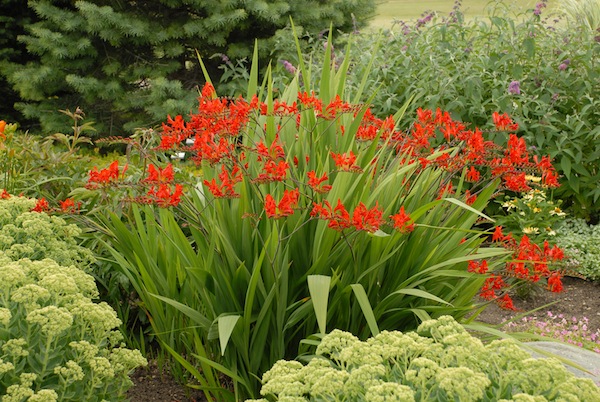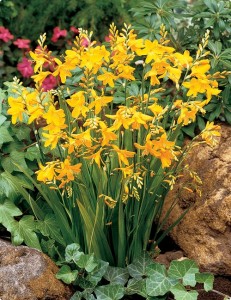
'Lucifer' crocosmia. Photo courtesy perennialresource.com
Last year I broke down and brought ‘Lucifer’ home. I brought another one home this year, too.
You just can’t beat the long flowering period and show of this little devil.
‘Lucifer’ (Crocosmia), a summer bulb-like plant, tempts hummingbirds (and humans) with large, arched branches of red tubular flowers.
In the family that includes gladiolus, crocosmia has been a staple of English gardens for decades. However, until recently, the varieties could not survive harsh Indiana winters.
Enter Blooms of Bressingham, a well known British plant breeder, who introduced the American public to ‘Lucifer,’ which by most accounts is rated USDA Zone 5, which makes it winter hardy throughout Indiana.
“You don’t have to do anything to ‘Lucifer’ to have it survive” Indiana’s winters, says Irvin Etienne, horticulture display coordinator at the Indianapolis Museum of Art.
Crocosmia (pronounced crow-coz’-me-ah) comes from the grasslands of South Africa, and can be grown from corms or seeds. Corms are under ground stems and can usually be found in bulb catalogs. Crocus is another example of a corm. Many garden centers also carry the plant.
Plant crocosmia in full sun and keep it well watered. Spider mites are the biggest pest. They suck the green from the sword like leaves, giving them a rusty hue. ‘Lucifer’ is in the 2- to 3-foot tall range when blooming. Cut back to the ground in fall.
Crocosmia blooms from July into September and makes an excellent cut flower. But be prepared. This plant elicits many ‘what’s that’ queries from passersby. And the hummingbirds, well, they know exactly what it is.
Garden centers usually only have the red ‘Lucifer’. Bulb catalogs offer crocosmia in yellow, gold and amber, but most of them are not hardy here.

'George Davidson' crocosmia. Photo courtesy dutchbulbs.com
Etienne recommends ‘George Davidson’ with an amber gold flower as another crocosmia that has done well for several winter seasons in a raised bed at the IMA and in his Fountain Square landscape.